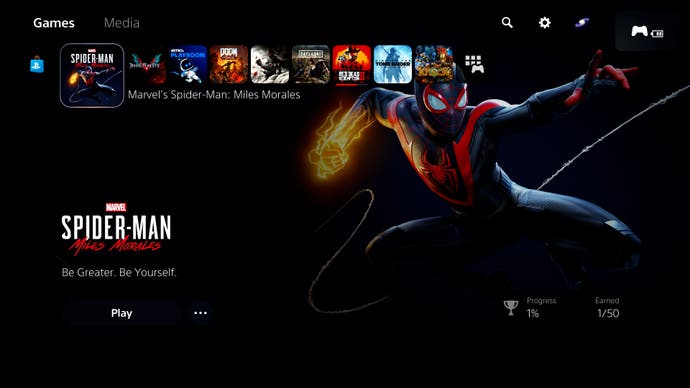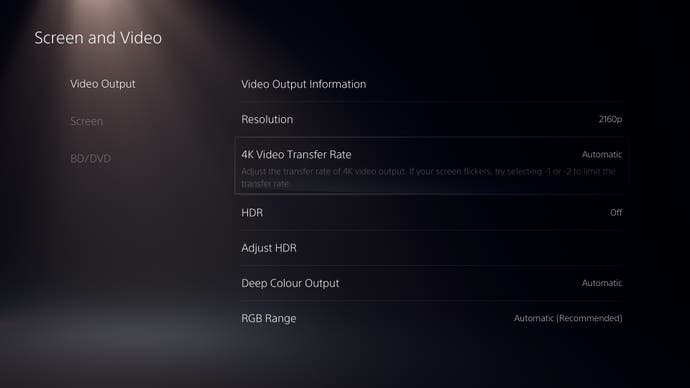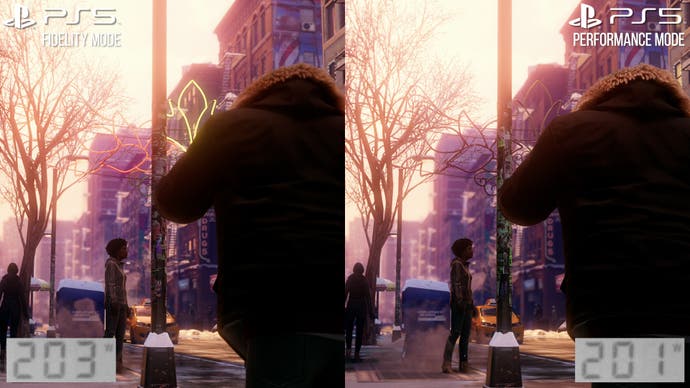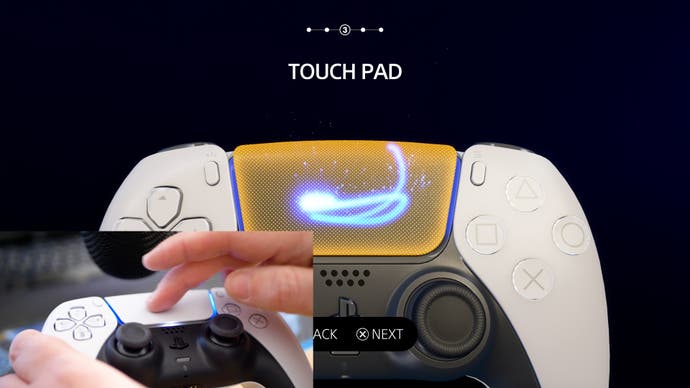PlayStation 5 review: welcome to the next generation
High five.
This is it. After months of waiting, we're finally in possession of the realisation of Sony's vision for the next generation of console gaming. PlayStation 5 features cutting-edge AMD CPU and graphics technology combined with ultra-fast solid state storage, ground-breaking innovations in the user interface, a revolutionary controller and, of course, 3D audio. The promise is enticing and by and large, the end product delivers. We've only had just over a week with final hardware, but from my perspective, PlayStation 5 is a home run.
Boot-up and interface
It starts with a press of the power button, eliciting the same ping as PS4 - but the similarity from one console generation to the next ends there. From a cold boot, PlayStation 5 is ready for use in less than 14 seconds (halve that if you're coming back from Rest Mode) and right off the bat, you're good to go. Yes, there's a system software update to download - but it's not mandatory and you're free to examine Sony's early UI if you want to. It's certainly a treat visually, rendering at native 4K with precision text, artwork and iconography. In many ways, I'm reminded of the utility of the PlayStation 4 front end and the pristine, high-end feel of the PS3's particle-heavy XMB. Sony's vision of delivering the next generation of gaming entertainment is perfectly encapsulated in a UI that feels futuristic and deluxe, and polished to the nth degree. The fact that everything is presented in high dynamic range adds to the quality of the presentation.
Of course, Sony has already revealed plenty about the user interface - but the emphasis has very much been on the activity cards for use in PlayStation 5 software, designed to give you more access to any given game and to aid in discovery. Popping into the settings icon on the top right, it's clear to see why: the nuts and bolts functions are very similar in nature to the PlayStation 4, with just minor tweaks. There are some interesting options, however. For example, if a game has quality or performance modes, the user interface allows you to choose which one you'd prefer the game to boot in. Perhaps this is indicative of a wider push for choice in game presentations? Certainly, the function works just fine in Marvel's Spider-Man: Miles Morales.

HDMI 2.1 features: 120Hz is there - but VRR and 8K are MIA
PlayStation 5 and Xbox Series X herald a new console generation - but the emergence of exciting, cutting-edge gaming hardware doesn't kick off in a vacuum. To get the most out of the new machines, you may wish to consider purchasing an HDMI 2.1 display and I was curious to see whether Sony had matched Microsoft's impressive commitment to this and other display formats.
Dipping into the video settings, we're looking at functionality very similar to PlayStation 4, only this time there is confirmation of HDMI 2.1 support - in the form of 4K 120Hz output recognised as a display spec point in the video output report. However, it appears that the user has no control over setting the console to 120Hz mode: this is engaged as and when a game requires it. In fact, one of the few disappointments I have with PlayStation 5 is that the HDMI 2.1 implementation as it stands right now is somewhat lacking in terms of embracing the full feature set. Beyond limited access to a display's 120Hz features, there is no sign whatsoever that variable refresh rate (VRR) is supported on PlayStation 5 right now - and that's a real shame. This is more of an academic point, but the PS5's packaging also moots 8K display functionality. This is somewhat frivolous and borderline pointless in the here and now, but I tried to get it working on a gigantic LG 75NANO99 native 8K screen, and found that despite flagging 8K compatibility on the box, PS5 tops out at 4K resolution.
I also saw no support for ALLM - auto low latency mode. With both Xbox and Nvidia RTX cards, the LG display automatically switches into game mode when they are attached. PlayStation 5 does not do so, meaning that it's down to the user to manually engage game mode for the lowest possible latency and I have to wonder how many mainstream users are likely to actually do this. And yes, no native support for 1440p desktop monitors is also confirmed. I have an AOC AG271QX display, which works just fine at 1440p resolution on Xbox consoles (with VRR functionality, no less) but the same screen tops out at just 1080p on PlayStation 5, meaning that game outputs will be downscaled from 4K, then upscaled by the screen to 1440p. Mileage may well vary on other screens, but I suspect the best you can hope for will be downscaled 2160p from HDMI 2.0-equipped 1440p monitors.
One final point: the video output section features a curious new feature: the ability to change 4K transfer rate from default to minus one and minus two. These correspond to 4:2:2 and 4:2:0 chroma subsampling respectively, with the default set to 'full fat' 4:4:4, which may tax cheaper HDMI cables or perhaps some displays. We recommend staying with the default option but in a living room set-up with the screen viewed at range, you may find it difficult to tell the difference.

PlayStation 5 hardware analysis: heat and power consumption
Thankfully, a lot more thought has gone into the physical design of the console itself. Yes, it's large and unwieldy and certainly not as media cabinet friendly as prior generations. It also seems fairly clear that similar to Series X, this is a machine designed to be placed in a vertical configuration: what looks futuristic and elegant (if imposing) when upright doesn't quite work when placed on its side, requiring the stand to sit comfortably at all - a stand that all too easily slips off the console when you move it.
It's a controversial design (as was PS4 back in the day), but it is what it is for a very specific reason - and it works. Put simply, in working with a high-power processor, heat generation (and dissipation) is a genuine issue. Microsoft's solution is a compact, dense piece of industrial design aimed at maximising airflow. Sony's alternative is sheer area: allowing heat to siphon off into a relatively gigantic cooler, expelled out of the case in several directions via a 120mm fan. The same problem is dealt with in very different ways - but crucially both of them work in delivering cool and quiet consoles.
First of all, similar to Series X, I think that noise is basically a non-issue with PlayStation 5. Close-up to the console, you can hear the slight whir of the fan, but in living room, office or bedroom conditions, this totally disappears into the ambient noise. Fan speeds (and thus noise) also seem remarkably consistent, and even ramping up power draw as much as I could with Marvel's Spider-Man: Miles Morales in photo mode - and then leaving the console alone for an hour - PlayStation 5 continued to be just as cool and quiet. The thermal photography of the system under load is literally illuminating.
The top of the machine is essentially at room temperature, and even in the centre of the unit where the SoC lurks, the console's skin temperature is in the mid-30s Celsius. Some of the excess heat leaves the console via the vents in the centre, where temperatures rise to the mid 40s. However, the back of PlayStation 5 is the main escape route for heat - the whole rear of the unit is basically a big vent and temperatures hit around 50 Celsius max here, generally. The hottest point in the thermal photography comes in at 57 Celsius on the LAN port, but I think that's just the nature of metal conducting heat and not anything to worry about. All told then, job done: PlayStation 5 is larger than Xbox Series X, but it is also cooler. The key point is that the days of jet engine acoustics emanating from your Sony console are a thing of the past.
Next up, I measured PlayStation 5's power draw in various scenarios and as is the tradition, I filmed the watt meter and synchronised the feed with system capture. On the front end, power consumption is quite high at 70 Watts but quickly drops back into the 60s, then as we boot into Marvel's Spider-Man: Miles Morales, we suddenly spike to around 200W. Dipping into Capcom's Devil May Cry 5: Special Edition, power draw also tops out at around the same figure. PlayStation 5's processor is based on the idea of a boost clock that fluctuates according to load, frequencies defined by a fixed power limit. Based on our tests, the evidence suggests that total system power consumption (without factoring in attached peripherals and such) is at the 200W level.
To put that 200 watts into perspective, God of War on the latest CUH-7200 PS4 Pro draws about 170 watts, and it's actually nudging 177W on a launch Pro. Perhaps more illuminating is that PlayStation 5 seems top out with the same level of power consumption as Xbox Series X running Gears 5 - the toughest work-out I could find for the Microsoft console. The Xbox mini-tower doesn't have a power cap like PlayStation 5 does, so there may well be more to extract from the Microsoft design, but the fact that both machines have nigh-on identical demands from the mains is intriguing. How this may (or may not!) translate into platform comparisons remains to be seen - as of this moment, we've yet to receive any games for both systems.
One final note on power: Rest Mode is extraordinarily efficient at just 1.5W average utilisation once the system is fully dormant and even PS4 Pro works out pretty well here too. The difference in power draw compared to turning the machine off completely is essentially negligible. Obviously though, you should expect higher power draw if a background download is taking place.

| Power Consumption | PlayStation 5 | PlayStation 4 Pro |
|---|---|---|
| Power Off | 1.3W | 1.5W |
| Rest Mode (Network Disabled) | 1.5W | 5W |
| Rest Mode (Downloading Game) | 36W | 50W |
| Front End (Idle) | 47W | 63W |
| Marvel's Spider-Man: Miles Morales (Peak) | 203W | TBC |
| Rise of the Tomb Raider (Peak, 30fps cap) | 107W | 147W |
| Knack (Peak, unlocked fps, PS5 locks to 60fps) | 135W | 148W |
Testing the DualSense controller and 3D Audio
Another key aspect of the PlayStation 5 design I want to address is the DualSense controller - which surpasses expectations, and actually presents a profound challenge to journalists in that describing how wonderful it is will never hold a candle to simply holding the controller and giving it a go. First of all, the design of the pad itself is exceptional, mirroring the high quality, premium feel of the entire experience. Sticks feel better, the d-pad massively so. The resistive triggers feel a little strange initially, but once you dive into Astro's Playroom, everything makes sense. DualSense feels revolutionary. Surfaces over which Astro walks can be felt through the pad, the wind and particles of a sandstorm are perfectly recreated, while the unique tension of a spring is uncannily represented. When it rains, it almost feels as if you can feel the individual drops hitting Astro. Part of the success of the experience is that DualSense uses both audio via the internal speaker and haptic feedback. I've long since muted the speaker on my PS4 DualShock 4 - 'remote' audio can come across as a gimmick and somewhat intrusive - but with Astro's Playroom, sound and sensation come together to create something extraordinary. This is HD rumble taken to the next level and I defy you not to be impressed by it.
Of course, playing devil's advocate, it's worth factoring in that Astro's Playroom is designed around the capabilities of the DualSense controller. It's as if its entire reason to exist is to showcase what the new pad is capable of - which is almost certainly the case. Moving over to Marvel's Spider-Man: Miles Morales, the effect is somewhat more muted, and nowhere near as much of a game-changer. That said, the combination of haptic response and audio when firing your web shooters is very well realised. It just feels natural, to the point where I had to hold up the pad to my ear to figure out exactly how sound and sensation were working together.
Miles Morales is also as good a test as we have for Sony's eagerly anticipated 3D audio, delivered via bespoke PlayStation 5 hardware: the Tempest Engine. We weren't supplied with a Sony 3D Pulse headset, but the beauty of the headphone-based rendition of the technology is that it should work well on any decent set of cans. With Spider-Man, there's the promise of something special here, but there's more the sense that traditional multi-speaker surround is simulated via headphones as opposed to anything more revolutionary. Certainly, we felt no real need to bin off a 7.1 surround sound system in favour of a 3D audio headphone experience with this title. It's the same with Astro's Playroom, a game specifically designed to showcase the next generation features of PlayStation 5. The effect is interesting and additive, but right now, it doesn't feel like a game-changer. My colleague, John Linneman, is a fan of binaural audio recordings, which aim to deliver truly lifelike soundscapes via speakers, and there's not the sense that 3D audio (such as it is right now) matches that. Of course, it is early days, and we'll be following this very closely - especially in the Sony first-party titles.

Storage and expandability
System storage is an important topic for the next generation of consoles. The move away from mechanical hard drives towards solid-state storage solutions is potentially revolutionary for games - but in a world where a 1TB storage expansion card for Xbox costs almost as much as a Series S console in its entirety, clearly, the costs are high. Perhaps prohibitively high. PlayStation 5 is marketed as delivering 825GB of storage, which translates into 667GB of available space to the end user, up against an actual 802GB on Xbox Series X and a mere 364GB on Series S. In a world where the 100GB game size barrier is routinely smashed - often dramatically so - the chances are that sooner or later, you're going to need an upgrade.
Sony's 'route one' solution isn't quite ready for showtime yet. Essentially, the firm promises to allow users to buy off-the-shelf PCIe 4.0 M.2 solid-state drives and to install them into the console. The white case surrounds on PS5 are very, very easily removed and adding a drive is simply a case of unscrewing the drive bay, plugging in your drive and screwing it into place. The only problem is, it doesn't work right now - there are no compatible drives so far. I realise it's early days and that third-party drives require extensive testing, but I truly hope that at launch - or close to it - Sony whitelists a compatible drive or two for use with the PlayStation 5. The alternative is to hive off your legacy titles to an external USB drive, but for PS5 games right now there is no other option. One final question for now: based on the recent teardown video from Sony itself, the M.2 bay doesn't seem to have any form of cooling - it seems to be fully enclosed, which is a slight concern - but I'm sure Sony are fully aware of the power draw of NVMe drives and the resultant heat output. [UPDATE 7/11/20 10:28am: A prior version of this article showed the M.2 update procedure which has had to be removed as Sony believes this contradicts aspects of its review guidelines - we will talk more about this soon.].
The wrap-up: PlayStation 5 is an exceptional console - and the games look terrific
This is in no way a complete technical lowdown on the PlayStation 5. There is still much more to test, from the suitability of various USB media, down to the 120Hz gaming implementation and of course, not forgetting the platform comparisons with Xbox Series X that many of our audience are waiting for (to reiterate: we've still not received any one game we can play on both systems). In the here and now, what I find remarkable is how two next generation consoles built from what are effectively the same AMD technologies (though Microsoft claims extra RDNA 2 features) can deliver such a drastically different first impression.
Xbox Series X presents the notion of latent power yet to be unleashed, and is almost conservative in its presentation - both in terms of its cuboid form factor and its UI, which is to all intents and purposes a smoother, slicker, faster version of the Xbox One interface. PlayStation 5 is an altogether different experience - a Buck Rogers physical design with system software that's fast, immediate, beautifully presented, and almost excessively eager to herald the arrival of a new generation of gaming, to the point where you're even given a pack-in game. Yes, Astro's Playroom fully deserves its Eurogamer Essential award, and strategically, it's a Wii Sports-style play from Sony that showcases a brilliant new controller - and it works.
Meanwhile, it's business as usual on the first-party front: Marvel's Spider-Man: Miles Morales may well be a cross-generational title, but it still manages to be a stunning workout for the new hardware that wouldn't look out of place on a high-end PC. Meanwhile, the Demon's Souls remake is not too far away and further first-party goodies are announced and en route. And did we mention just how good the backwards compatibility turned out to be? And that select PS4 Pro games like Ghost of Tsushima and Days Gone are already running at 60 frames per second? Microsoft laid down the gauntlet and it's good to see Sony rising to the challenge. Sony may well be wedded to the notion of the console generation, but the PlayStation 4 library has not been left behind.
This is PlayStation 5 - and it's terrific.








